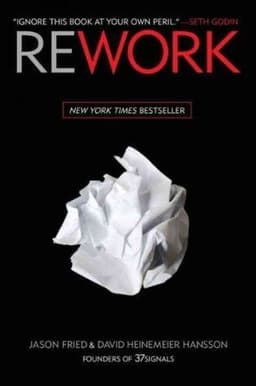
Rework Book Summary
Book by Jason Fried, David Heinemeier Hansson
Summary
"Rework" challenges conventional wisdom on building businesses, offering a simpler, faster, more direct approach to succeeding by staying small, nimble, and true to yourself.
Sign in to rate
Average Rating: 5
Rework Challenges Conventional Wisdom On Building Businesses
In the introduction, the authors explain that Rework is based on their experience building a successful company, 37signals. The book aims to show an easier, faster, more direct way to succeed in business. It rejects many "rules" of business and advocates for a simpler, no-nonsense approach focused on getting things done. The authors emphasize this isn't based on academic theories, but real-world experience in building a profitable business.
Section: 1, Chapter: 1
"Later, You Won't Be Pumped Up About It Anymore"
"If you want to do something, you've got to do it now. You can't put it on a shelf and wait two months to get around to it. You can't just say you'll do it later. Later, you won't be pumped up about it anymore."
Section: 1, Chapter: 1
The Real World Isn't A Barrier, It's An Excuse
People often shoot down new ideas, saying "that won't work in the real world." But the authors argue the real world isn't a valid excuse. It's a self-imposed limitation. Just because something seems unrealistic doesn't mean it's impossible. Most things labeled impossible are really just things no one has bothered to try yet in that particular way. Don't constrain your ambitions based on what others claim is the "real world." Create your own reality instead.
Section: 1, Chapter: 2
Focus On Making A Dent In The Universe
To do great work that matters, you need to feel you're making a difference in the world. Your efforts need to resonate and bring real value to people's lives. It doesn't require curing cancer - it just means focusing your energies on work you find meaningful that improves things for others in some way, even if in a small part of the universe. Making your work a "dent" gives you a sense of purpose and ensures you prioritize the things that have true lasting impact.
Section: 1, Chapter: 2
Scratch Your Own Itch
The best way to create something great is to make something you want to use yourself. Then you can:
- Design based on firsthand knowledge, not assumptions
- Directly assess the quality and usefulness of what you make
- Rely on your own enthusiasm for the product to drive you forward
When you solve your own problem, you achieve a level of understanding and passion that's difficult to replicate when making things for others. So start by addressing your own needs and desires. Odds are others will share them too.
Section: 1, Chapter: 2
Failure Is Not A Rite Of Passage
Business folklore romanticizes failure as an essential step on the path to success. But the authors argue this is misguided logic. Failure is not a prerequisite for success. The goal is to succeed, not fail first. While you can learn from mistakes, you can also learn from successes - both your own and others'. Focus on what works, not what doesn't. Studying and replicating success is more constructive than mythologizing failure as a required rite of passage.
Section: 1, Chapter: 3
Plans Let The Past Drive The Future
"Plans let the past drive the future. They put blinders on you. 'This is where we're going because, well, that's where we said we were going.' And that's the problem: Plans are inconsistent with improvisation."
Section: 1, Chapter: 3
Don't Obsess Over Growth For Its Own Sake
Blind pursuit of business growth invites unnecessary complexity and problems. Growth alone doesn't guarantee profits, impact or longevity. Sometimes the right size for your ambitions is small - a size you can manage while maintaining freedom and focus. Don't assume getting as big as possible as fast as possible is the only goal. Question if expansion really fits your definition of success and is essential to fulfill your mission. Often the best growth is slow, controlled and deliberate.
Section: 1, Chapter: 3
Outside Funding Should Be A Last Resort
Seek outside money only if absolutely necessary. Bootstrapping gives you more control. With investors, you have to answer to others who may not share your vision. Pursuit of an "exit" so investors can recoup their stake takes priority over long-term sustainability. And the mentality of spending other people's money breeds bad, unsustainable habits. Unless your endeavor absolutely requires major upfront capital, find a way to self-fund through savings, sales, or trading services. Your freedom is worth more than easy money.
Section: 1, Chapter: 4
Build A Business, Not Just A Client Portfolio
Avoid the trap of doing client work to fund your product business. This makes you a consultant, not an entrepreneur. Your efforts go into serving clients, not building something scalable that can thrive without you. It's a tempting compromise, but it splits your focus.
You wind up with a viable portfolio but not a viable product. If you want a product business, make that your main focus from day one. Use your own resources and find a way to start generating revenue directly.
Section: 1, Chapter: 4
Embrace Constraints As A Catalyst For Creativity
Having fewer resources drives resourcefulness. When you have unlimited time, money or people, inefficiency and waste emerge. But constraints breed creativity and clarity. With tight limitations you must:
- Solve problems simply, not elaborately
- Focus only on what's essential
- Find unorthodox ways to make do with what you have
Don't lament lacking resources. Treat finite means as a source of innovation. Let your constraints guide you to elegant, creative solutions instead of bloated, complex ones.
Section: 1, Chapter: 5
Great Products Require Saying No
Making a great product is as much about what you leave out as what you put in. Extraneous features, options and preferences make products confusing, diluted, and bloated. They require more work and maintenance. And they bury the product's true purpose. So be a curator, not a hoarder. Constantly trim and prune. Limit your product to the essential. Learn to say no to additions that don't support the product's core use or value. When in doubt, leave it out.
Section: 1, Chapter: 5
Break Big Time Frames Into Tiny Intervals
Estimates, especially long-term ones, are always wrong. The solution is to break big tasks and time frames into the smallest possible units. Instead of one 12-week project, frame it as 12 one-week projects.
By planning one week at a time, your estimates get more realistic. Your assumptions are regularly tested. You avoid investing heavily into plans that prove misguided later. When timeframes or tasks prove bigger than expected, you can adjust tactically without derailing the whole project.
Section: 1, Chapter: 5
Copying Others Makes You A Follower, Not A Leader
Copying others' innovations means you're always following, not leading. You just replicate the surface elements without understanding the deeper insights that led to them. So while that tactic might help you keep pace, it won't put you in first place. You remain a commodity with no real advantage.
Instead of copying what exists, look for untapped opportunities others have missed. Seek to solve unsolved problems in the market. That's where you can innovate as a leader, not follow as an imitator.
Section: 1, Chapter: 6
Pour Yourself Into Your Product To Make It Uniquely Valuable
To avoid being a commodity that others can easily replicate, inject unique elements of yourself into your product. Infuse it with your values, identity, and personality.
Incorporate your way of thinking and working into how you build, deliver, and support it. By pouring yourself into your product, you make it an extension of you. No competitor can copy that. Your product won't just perform a function - it will represent a distinctive worldview customers can identify with.
Section: 1, Chapter: 6
Pare Down To The Essence, But Don't Remove The Poetry
"Pare down to the essence, but don't remove the poetry. Keep things clean and unencumbered but don't sterilize."
Simplicity is essential, but it requires careful judgment. The goal is to pare down to the essence, but not overshoot into sterility. Too much removal makes a product lifeless. So as you simplify, don't just cut - refine. Keep the essential core but also retain the poetic touches that make your product engaging, memorable, and human. The right details make simplicity sing.
Section: 1, Chapter: 7
Don't Let Your Customer Outgrow You
As your customers grow, some will develop needs and ambitions beyond what your product can fulfill. If you try to satisfy them by tacking more and more onto your product, you can wind up with a complicated, overbuilt mess none of your customers can use.
Don't underestimate the continuing market for "simple." Let advanced customers graduate to more complex products when they must. Stay true to your product vision. Keep your product clean, simple and narrowly focused so new customers can always get started easily.
Section: 1, Chapter: 7
Decisions Are Progress, So Make Lots Of Them
When you put off decisions, they pile up. Unmade decisions accumulate and complicate each other, creating stress and stagnation. The solution is to decide early and often, even when information is incomplete.
Don't treat decisions as permanent. Make the best call you can now with the information you have. You can revisit it later if things change. The important thing is not to sacrifice momentum. Keeping the decision train rolling, even if imperfectly, maintains your pace and morale.
Section: 1, Chapter: 7
Obscurity Helps You Improve Without Scrutiny
When you're unknown, you can try new things without expectations or pressure. No one is watching, so you're free to experiment out of the spotlight.
Obscurity protects you from criticism as you find your voice and vision. You can iterate boldly without fear of public failure or ridicule. So be glad no one has heard of you. Enjoy the freedom to make mistakes, learn, and improve. Once you're established, that flexibility to experiment diminishes. Use obscurity to evolve your idea safely.
Section: 1, Chapter: 8
Build An Audience Organically By Sharing Passion And Knowledge
The way to build an audience is to share passion and knowledge so generously that people keep coming back to learn more. Speak, write, blog, tweet, make videos - whatever medium showcases your expertise and enthusiasm.
Deliver information your audience craves. Make them smarter. Give them insights they can't find elsewhere. Help them so much with your free content that they'll line up to pay for your premium offerings later. An audience built organically through sharing beats one bought through ads any day.
Section: 1, Chapter: 8
Apologies Should Be Genuine, Specific, And Selfless
Canned corporate apologies that deflect responsibility do more harm than good. A real apology expresses genuine empathy for those impacted. It admits full fault. It acknowledges the real severity of the problem. And it focuses on making things right for the wronged party more than rehabilitating the company's image.
Infuse your apology with humanity, not legalese. Speak as an individual, not an institution. Replace "we regret any inconvenience this may have caused" with "I'm deeply sorry for the major disruption and pain we brought on you." Sincerity heals.
Section: 1, Chapter: 8
Hire Managers Of One
"Managers of one are people who come up with their own goals and execute them. They don't need heavy direction. They don't need daily check-ins. They do what a manager would do - set the tone, assign items, determine what needs to get done, etc. - but they do it by themselves and for themselves."
Section: 1, Chapter: 9
Evaluate Applicants By Testing Them With Real Work
Resumes and interviews are poor predictors of actual work performance. The only reliable way to assess a candidate is to see them in action. So hire them for a mini project first. Give them a small job that's identical or analogous to the real work they'd be doing.
Then evaluate their actual output. It could be a design mockup, a code module, a writing sample - anything demonstrating real skills. What you learn from a little test project is far more useful than what you glean from an interview.
Section: 1, Chapter: 9
Can't Apologize Your Way Out Of Being An Ass
Even the most eloquently crafted apology falls flat if you haven't built goodwill with your audience beforehand. Treating people well when things are calm is more important than anything you say after a crisis.
To communicate genuine concern during a fiasco, you must demonstrate genuine concern consistently ahead of time. If people know you care about more than just saving face, they'll extend more patience and forgiveness. But you can't talk your way out of a poor track record. Your response matters, but your reputation matters more.
Section: 1, Chapter: 10
Artificial Culture Is Useless, Real Culture Emerges From Consistent Behavior
You don't create a corporate culture by proclaiming abstract values in a mission statement or manifesto. Culture emerges organically from how a company operates day to day. If a company claims to value transparency but makes decisions privately, the real culture is one of secrecy, not openness. To shape culture, focus on practicing the behaviors you want consistently over time.
Section: 1, Chapter: 11
Culture Is A Byproduct, Not An Objective Itself
You don't install a culture, you cultivate it slowly through your actions and policies. Perks and slogans don't make a culture, they reflect it. Culture is an outcome, not an input. If you encourage sharing, you get a sharing culture. If you reward trust, you develop a culture of trust. If you practice transparency, you build a transparent culture. How you behave as a company determines your culture more than anything you say. Focus on your behaviors and your cultural aspirations will follow.
Section: 1, Chapter: 11
Avoid Long-Term Abstractions, Focus On Concrete Daily Needs
Don't agonize over decisions based on imaginary far-future scenarios. What your company might hypothetically need someday is not as important as what it definitely needs now. Borrowing trouble from the future is counterproductive.
Focus on the tangible problems you face today. Make your immediate next step the right one for your current reality and resources. Don't contort your business to fit a theoretical "what if" vision. Concentrate your energies on what you can control now, not what you can speculate about later.
Section: 1, Chapter: 11
Inspiration Is Perishable, So Act On It Immediately
When you're inspired, seize the moment. Inspiration is a renewable but fleeting resource. It comes often but evaporates quickly. When a great idea strikes, act on it while your enthusiasm is hot. If you wait, your motivation will fade and the work will become a chore.
Pounce on inspiration and ride it to completion. You can analyze, refine and edit later. But nothing will happen without an initial burst of inspired energy. So when inspired, clear your plate, lock yourself away, and get as much done as you can while the spirit is with you.
Section: 1, Chapter: 12
Related Content
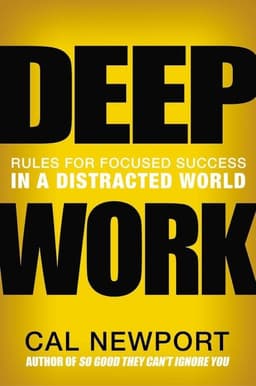
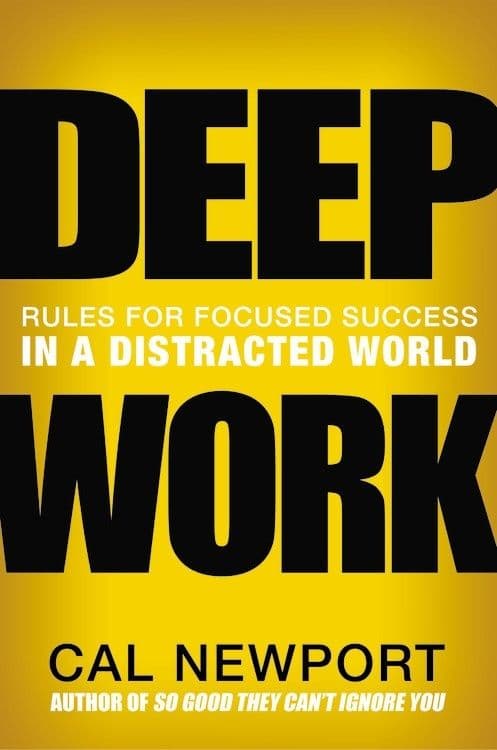
Deep Work Book Summary
Cal Newport
In "Deep Work", Cal Newport argues that the ability to focus intensely on cognitively demanding tasks is becoming increasingly rare yet increasingly valuable in our economy, and provides a training regimen to cultivate this skill through the application of four rules: work deeply, embrace boredom, quit social media, and drain the shallows.
In "Deep Work", Cal Newport argues that the ability to focus intensely on cognitively demanding tasks is becoming increasingly rare yet increasingly valuable in our economy, and provides a training regimen to cultivate this skill through the application of four rules: work deeply, embrace boredom, quit social media, and drain the shallows.
Productivity
Personal Development
Time Management
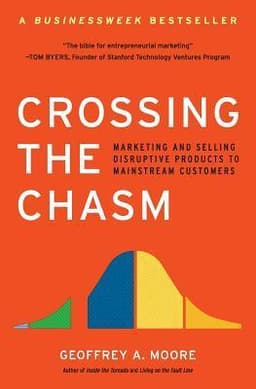
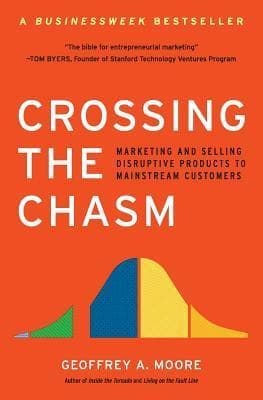
Crossing the Chasm Book Summary
Geoffrey Moore
"Crossing the Chasm" unveils the hidden challenges of launching disruptive technologies and provides a proven roadmap for navigating the treacherous gap between early adopters and mainstream markets, enabling companies to achieve market leadership and sustainable growth.
"Crossing the Chasm" unveils the hidden challenges of launching disruptive technologies and provides a proven roadmap for navigating the treacherous gap between early adopters and mainstream markets, enabling companies to achieve market leadership and sustainable growth.
Business
Management
Technology
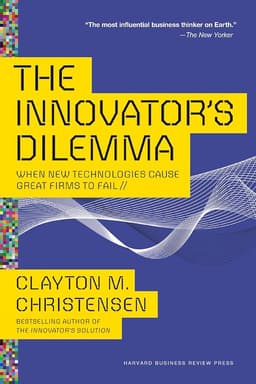
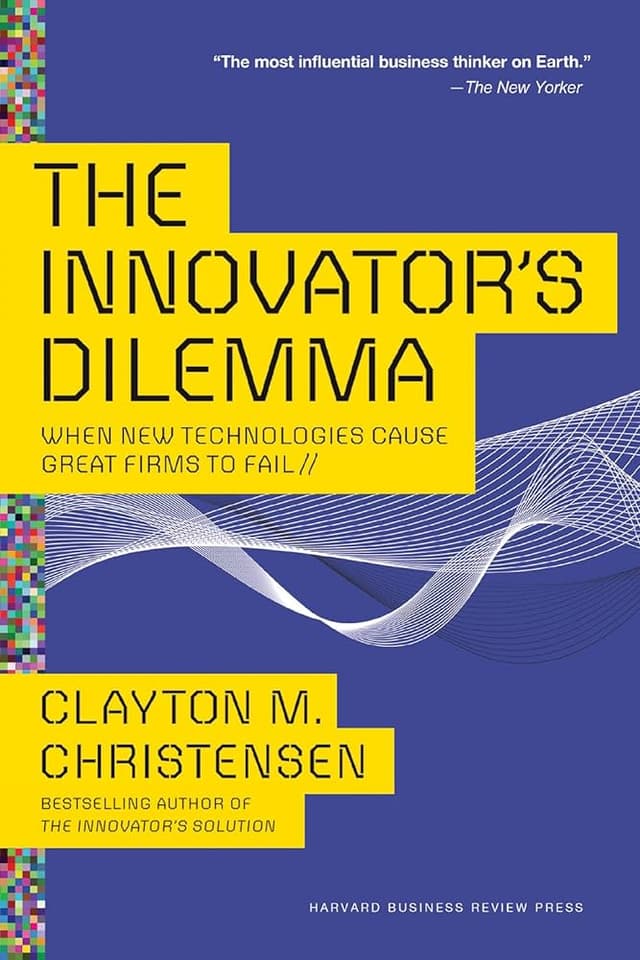
The Innovator's Dilemma Book Summary
Clayton M. Christensen
"The Innovator's Dilemma" unveils a paradoxical truth: successful companies are often perfectly positioned to fail. Established firms can become blindsided by disruptive technologies that reshape industries. This book offers a framework for navigating these disruptive threats, urging companies to embrace new market opportunities and transform themselves to thrive in the face of inevitable change.
"The Innovator's Dilemma" unveils a paradoxical truth: successful companies are often perfectly positioned to fail. Established firms can become blindsided by disruptive technologies that reshape industries. This book offers a framework for navigating these disruptive threats, urging companies to embrace new market opportunities and transform themselves to thrive in the face of inevitable change.
Business
Innovation
Management

